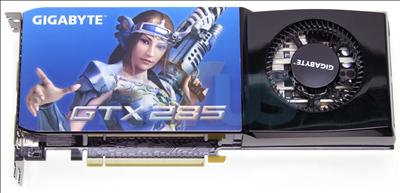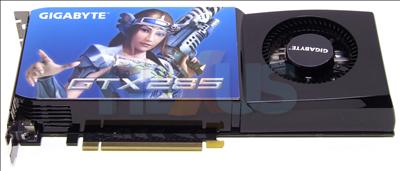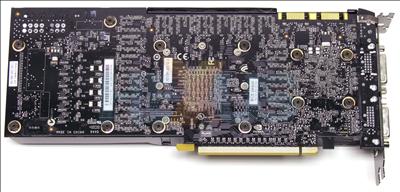Lookin' familiar - GIGABYTE's GeForce GTX 285
We've seen something like this before, it's essentially the GeForce GTX 280 casing with revised innards. Measuring 268mm(W) x 111m(H) x 36mm(D) and weighing 824g, it's nothing new in the aesthetics department.
Sadly, the black-matte finish found on the GTX 295 - which we happened to find rather tasteful - doesn't carry over. We're back to fingerprint-prone gloss.
We're struggling to find commentary for a now very-familiar design. Wait, there's a number 5 where we usually see a 0, and the customary digital gamer-girl could be holding a new weapon.
Over to the rear and you'll find things have changed - gone is the enclosure and the PCB (printed circuit board) is in full view.
The two SLI links, located top right as we look at it, provide connectivity for some of that three-way SLI goodness.
On the top left you'll find a pair of power connectors and the GeForce GTX 285's lower-power credentials help it get away with two of the six-pin variety.
At 36mm in depth, the card looks as chunky and menacing as ever. NVIDIA's reference cooling solution hasn't changed and though we expect most launch-day cards to be dual-slot models, it's only a matter of time until we see custom-cooled jobs and possibly single-slot water-cooled alternatives, too.
The card achieves fairly-quiet operation when in 2D mode, thanks to GPU and memory clocks being throttled to 300MHz and 1,000MHz, respectively. In full-on 3D, it's audible and borderline loud.
There's little to get excited about in terms of connectivity, but we've the good ol' dual-link DVI.
Summary
It's clearly difficult to get excited about a card that looks and feels the same, and though we'd have preferred some form of distinct differentiation between this and the GeForce GTX 280, we need to remember that this is an evolution rather than a revolution. Besides, it's those new higher-clocked innards that really count...














